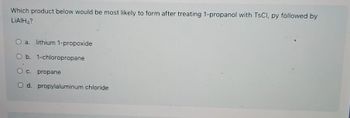
Chemistry
10th Edition
ISBN: 9781305957404
Author: Steven S. Zumdahl, Susan A. Zumdahl, Donald J. DeCoste
Publisher: Cengage Learning
expand_more
expand_more
format_list_bulleted
Concept explainers
Question

Transcribed Image Text:Which product below would be most likely to form after treating 1-propanol with TSCI, py followed by
LIAIH?
O a. lithium 1-propoxide
O b. 1-chloropropane
O c. propane
O d. propylaluminum chloride
Expert Solution
This question has been solved!
Explore an expertly crafted, step-by-step solution for a thorough understanding of key concepts.
Step by stepSolved in 3 steps with 1 images

Knowledge Booster
Learn more about
Need a deep-dive on the concept behind this application? Look no further. Learn more about this topic, chemistry and related others by exploring similar questions and additional content below.Similar questions
- QUESTION 2 The preparation of a Wittig salt from an alky halide and triphenylphosphine proceeds by a(n) O A. E2 O B. Sn2 OC. E1 O D. free radical O E. Sn1 mechanism. QUESTION 3 Which resonance structure is more reactive as a nucleophile? Ph Ph O A. 1 O B. 2 OC. both are equally reactive Click Save and Submit to save and submit. Click Save All Answers to save all answers. o search F10 F1 F2 F3 F4 F5 F6 23 2 3 4. 7 8 W Y UIarrow_forwardWhich will complete the following reactions? Choices: A. HBr / ether B. PBr3 / ether C. SOCl2 / pyridine D. Br2 / NBS E. Chlorocyclopentane F. Cyclopentanol G. Iodobenzenearrow_forward2. Predict the major organic product(s) for each of the following reactions. Be sure to clearly indicate the proper stereochemical relationships between groups (if appropriate), and write the word "racemic" next to any compound that is formed as a racemic mixture. a. b. C. d. e. f. H3C H 2) H3O+ NaCN aq. NaOH NH NaOH H₂O, A CN 1) LiAlH4 2) H₂O HO CN H3O A g. Hic i CH₂ H3C NaCN aq. NH4Cl H3C. NH2 SOCI2 pyridine h. CN 1) PhMgBr H3C CH3 2) H3O+ i. H3C CN NaOH Ph CH3 H₂O j. 1) LiAlH4 N' Ph H 2) H₂O k. CN H3C H3O CH3 A I. OH 1) LiAlH4 Ph CN 2) H₂O m. H3C CN 1) i-Bu₂AIH CH3 Ph 2) H3O+ n. NH2 1) H3OA H3C CN 2) neutralizearrow_forward
- Question 20arrow_forwardV: Convert the following from the indicated starting material and any other possible reagents: this might take more than one step. C a. b. HO. NH₂ Br شد to to to to O CN NIT OHarrow_forwardWhich of the following provides the best description of the two products of the following ether cleavage? HBr, A a. two alcohols b. cyclic ether C. 2-propanol and 2-bromobutane d. 1-propanol and 2-bromopropane e. 1-propanol and 2-propanol f. 1-bromopropane and 2-propanolarrow_forward
- Which of the following alkyl halides undergoes the fastest SN2 reaction with sodium methylthiolate, NaSMe? a. methyl iodide b. ethyl iodide c. 2-bromopropane d. tert-butyl chloride a O b O c O darrow_forward1. Which alkyl bromide is the best choice to use as a reagent in a Williamson ether synthesis of 2-propoxybutane? A Br A B OCH3 2. What is the product of this alkoxymercuration-demercuration reaction? B OCH₂ C H₂CO Br 1. Hg(OAc)2, CH3OH 2. NaBH4 C HyCO. D Darrow_forwardSpecify both the alcohol starting material and the reagents you would use in each step in a synthesis of the compound shown. If the synthesis requires only two steps enter "none" for step 3. r Alcohol Starting Materials 1. methanol 2. ethanol 3. 1-propanol 4. 2-propanol 5. cyclohexanol Reagents available a. LiAlH₁ f. PBr3 b. H₂SO4 c. HCI d. HBr i. CH3 MgBr; then H3O+ e. SOC1₂ j. CH3 CH₂ MgBr; then H3O+ g. CrO3, H₂ SO4, H₂O h. NaH k. CH3 CH₂ CH₂ MgBr; then H3O+ I. C6H5 MgBr (phenylmagnesium bromide); then H3O+ m. (CH3)2 CHMgBr: then H3O+t n. Dess-Martin periodinane (DMP) Write the number/letters of the alchol/reagents in the boxes below. Alcohol starting material Reagent for step 1 Reagent for step 2 Reagent for step 3arrow_forward
arrow_back_ios
arrow_forward_ios
Recommended textbooks for you
 ChemistryChemistryISBN:9781305957404Author:Steven S. Zumdahl, Susan A. Zumdahl, Donald J. DeCostePublisher:Cengage Learning
ChemistryChemistryISBN:9781305957404Author:Steven S. Zumdahl, Susan A. Zumdahl, Donald J. DeCostePublisher:Cengage Learning ChemistryChemistryISBN:9781259911156Author:Raymond Chang Dr., Jason Overby ProfessorPublisher:McGraw-Hill Education
ChemistryChemistryISBN:9781259911156Author:Raymond Chang Dr., Jason Overby ProfessorPublisher:McGraw-Hill Education Principles of Instrumental AnalysisChemistryISBN:9781305577213Author:Douglas A. Skoog, F. James Holler, Stanley R. CrouchPublisher:Cengage Learning
Principles of Instrumental AnalysisChemistryISBN:9781305577213Author:Douglas A. Skoog, F. James Holler, Stanley R. CrouchPublisher:Cengage Learning Organic ChemistryChemistryISBN:9780078021558Author:Janice Gorzynski Smith Dr.Publisher:McGraw-Hill Education
Organic ChemistryChemistryISBN:9780078021558Author:Janice Gorzynski Smith Dr.Publisher:McGraw-Hill Education Chemistry: Principles and ReactionsChemistryISBN:9781305079373Author:William L. Masterton, Cecile N. HurleyPublisher:Cengage Learning
Chemistry: Principles and ReactionsChemistryISBN:9781305079373Author:William L. Masterton, Cecile N. HurleyPublisher:Cengage Learning Elementary Principles of Chemical Processes, Bind...ChemistryISBN:9781118431221Author:Richard M. Felder, Ronald W. Rousseau, Lisa G. BullardPublisher:WILEY
Elementary Principles of Chemical Processes, Bind...ChemistryISBN:9781118431221Author:Richard M. Felder, Ronald W. Rousseau, Lisa G. BullardPublisher:WILEY

Chemistry
Chemistry
ISBN:9781305957404
Author:Steven S. Zumdahl, Susan A. Zumdahl, Donald J. DeCoste
Publisher:Cengage Learning

Chemistry
Chemistry
ISBN:9781259911156
Author:Raymond Chang Dr., Jason Overby Professor
Publisher:McGraw-Hill Education

Principles of Instrumental Analysis
Chemistry
ISBN:9781305577213
Author:Douglas A. Skoog, F. James Holler, Stanley R. Crouch
Publisher:Cengage Learning

Organic Chemistry
Chemistry
ISBN:9780078021558
Author:Janice Gorzynski Smith Dr.
Publisher:McGraw-Hill Education

Chemistry: Principles and Reactions
Chemistry
ISBN:9781305079373
Author:William L. Masterton, Cecile N. Hurley
Publisher:Cengage Learning

Elementary Principles of Chemical Processes, Bind...
Chemistry
ISBN:9781118431221
Author:Richard M. Felder, Ronald W. Rousseau, Lisa G. Bullard
Publisher:WILEY